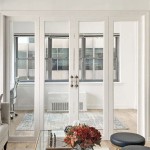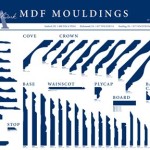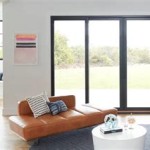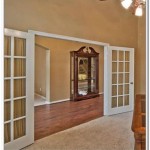Using Stick-On Panels To Update Your Interior Doors And Trim
Interior doors and trim play a significant role in the overall aesthetic of a home. Outdated or worn doors and trim can detract from even the most meticulously decorated rooms. Traditionally, updating these elements required extensive work, including sanding, painting, and sometimes even complete replacement. However, stick-on panels offer a modern and less invasive alternative, allowing homeowners to revitalize their interior spaces with relative ease and affordability.
Stick-on panels, also known as applied molding or decorative door panels, are thin, pre-finished pieces of material designed to adhere directly to existing door and trim surfaces. These panels come in a variety of styles, ranging from simple, minimalist designs to more ornate and traditional patterns. The ease of installation and the wide range of available designs make stick-on panels an attractive option for homeowners seeking to enhance their interior décor without the complexities and expenses associated with traditional renovation methods.
This article will explore the benefits, selection process, installation techniques, and maintenance considerations associated with using stick-on panels to update interior doors and trim. By understanding these aspects, homeowners can make informed decisions about whether stick-on panels are the right solution for their interior design needs and achieve professional-looking results.
Key Point 1: Advantages of Using Stick-On Panels
The rising popularity of stick-on panels is largely due to the numerous advantages they offer compared to traditional door and trim renovation methods. These advantages encompass cost-effectiveness, ease of installation, design versatility, and minimal disruption to the household.
One of the most compelling benefits of stick-on panels is their cost-effectiveness. Replacing doors and trim entirely can be a significant investment, involving not only the cost of new materials but also the expense of professional installation. Stick-on panels, on the other hand, are considerably more affordable. They eliminate the need to purchase new doors or trim and significantly reduce labor costs, as most homeowners can install them themselves with basic tools and minimal experience. This makes them an accessible option for homeowners on a budget who still desire a noticeable upgrade to their interior spaces.
The ease of installation is another significant advantage. Traditional methods often require extensive sanding, priming, and multiple coats of paint, which can be time-consuming and require specialized skills. Stick-on panels, however, typically involve a simple process of measuring, cutting (if necessary), and adhering the panel to the existing surface. Many panels come with pre-applied adhesive backing, further simplifying the installation process. This ease of installation allows homeowners to complete the project within a relatively short timeframe and with minimal disruption to their daily routines.
Stick-on panels also offer a wide range of design versatility. They are available in various styles, colors, and materials, allowing homeowners to customize the look of their doors and trim to match their existing décor or create a completely new aesthetic. Whether the goal is to add a touch of elegance with raised panels, create a modern feel with minimalist designs, or enhance a traditional style with ornate detailing, stick-on panels provide options to suit a variety of preferences. This versatility allows homeowners to achieve a personalized and cohesive look throughout their home.
Finally, using stick-on panels minimizes disruption to the household. Traditional renovation projects can create significant mess and inconvenience, requiring homeowners to move furniture, cover floors, and deal with dust and paint fumes. Stick-on panels, however, generate minimal mess and require no extensive preparations. The installation process is relatively clean and quiet, allowing homeowners to continue living in their home comfortably during the renovation process. This is particularly beneficial for families with young children, individuals with allergies, or those who prefer to avoid the hassles associated with traditional renovation projects.
Key Point 2: Selecting the Right Stick-On Panels
Choosing the appropriate stick-on panels is crucial for achieving a successful and aesthetically pleasing outcome. Several factors should be considered during the selection process, including material, style, size, and adhesive quality.
The material of the stick-on panel significantly impacts its durability, appearance, and overall performance. Common materials include wood, PVC, and MDF (Medium-Density Fiberboard). Wood panels offer a natural and elegant look but may be more susceptible to moisture damage and require more maintenance. PVC panels are water-resistant and easy to clean, making them a suitable option for bathrooms and kitchens. MDF panels are a cost-effective alternative that can be painted or finished to match existing décor. Each material has its own advantages and disadvantages, and the best choice depends on the specific application and homeowner preferences.
The style of the stick-on panel should complement the existing architectural style and décor of the home. Traditional homes may benefit from raised panel designs or ornate moldings, while modern homes may be better suited to minimalist and geometric patterns. Consider the overall aesthetic of the room and choose panels that enhance the existing design elements. It is also important to consider the scale of the panels in relation to the size of the door or trim. Overly large panels may overwhelm smaller doors, while overly small panels may appear insignificant on larger surfaces.
Accurate measurements are essential for ensuring a proper fit and seamless integration of the stick-on panels. Measure the dimensions of the doors and trim carefully, taking into account any existing moldings or architectural details. When purchasing panels, choose sizes that closely match the measurements, or select larger panels that can be easily cut to size. Proper measurements will minimize the need for extensive trimming and ensure a professional-looking finish.
The adhesive quality of the stick-on panel is critical for ensuring long-lasting adhesion and preventing the panels from peeling or detaching over time. Look for panels with strong, high-quality adhesive backing. If the panels do not come with pre-applied adhesive, choose a suitable adhesive specifically designed for bonding to wood, PVC, or MDF. Ensure that the adhesive is compatible with the existing surface material and follow the manufacturer's instructions carefully during application. Proper surface preparation, such as cleaning and sanding, can also improve adhesion.
Key Point 3: Installation and Maintenance of Stick-On Panels
Proper installation and maintenance are essential for maximizing the lifespan and aesthetic appeal of stick-on panels. Following the correct installation techniques and implementing a regular cleaning routine will ensure that the panels remain securely attached and maintain their original appearance.
Prior to installation, thorough surface preparation is crucial. Clean the doors and trim thoroughly with a mild detergent to remove any dirt, grease, or dust. For painted surfaces, lightly sanding the area with fine-grit sandpaper can improve adhesion. Ensure that the surface is completely dry before applying the stick-on panels. This step is critical for ensuring a strong and lasting bond between the panels and the existing surface.
Accurate cutting and trimming are essential for achieving a seamless and professional-looking finish. Use a sharp utility knife or saw to cut the panels to the desired size and shape. When cutting, it is helpful to use a straightedge or template to ensure clean and precise lines. For intricate cuts or curves, consider using a jigsaw or coping saw. After cutting, smooth any rough edges with sandpaper to prevent splintering or chipping. Taking the time to cut and trim the panels accurately will significantly enhance the overall appearance of the finished project.
When applying the stick-on panels, carefully align them with the edges of the door or trim. Start by peeling back a small portion of the adhesive backing and positioning the panel in place. Once the panel is properly aligned, gradually peel away the remaining backing while pressing firmly against the surface. Use a roller or rubber mallet to apply even pressure and ensure that the panel is fully adhered. Pay particular attention to the edges and corners, as these areas are most prone to lifting or peeling. Working slowly and methodically will help to prevent air bubbles and ensure a smooth, seamless application.
Regular cleaning is essential for maintaining the appearance of stick-on panels. Use a soft cloth and mild detergent to wipe down the panels regularly, removing any dust, dirt, or fingerprints. Avoid using harsh chemicals or abrasive cleaners, as these can damage the surface of the panels. For stubborn stains or scuffs, try using a specialized cleaner designed for the specific material of the panels. Periodic cleaning will help to keep the panels looking their best and extend their lifespan.
Inspect the panels regularly for any signs of damage or wear. If any panels become loose or detached, reapply adhesive as needed. For minor scratches or chips, touch-up paint or filler can be used to restore the original appearance. Addressing any issues promptly will prevent them from escalating and ensure that the panels continue to enhance the beauty of the interior space. By following these installation and maintenance guidelines, homeowners can achieve a professional-looking result and enjoy the benefits of stick-on panels for years to come.

Easy Flat To 6 Panel Interior Door Makeover Joyful Derivatives

Easy Flat To 6 Panel Interior Door Makeover Joyful Derivatives

Easy Flat Panel Door Makeover The Stonybrook House

How To Add Trim Plain Doors The Painted Hive

Easy Flat Panel Door Makeover Average But Inspired

A Guide To Updating Your Doors And Hardware Jenna Sue Design

Easy Flat Panel Door Makeover Average But Inspired

How To Refresh Hollow Core Doors A Beautiful Mess

How To Majorly Update Flat Panel Doors On A Budget Sprucing Up Mamahood

Master Makeover Diy Plain To Paneled Door Jenna Sue Design
Related Posts








